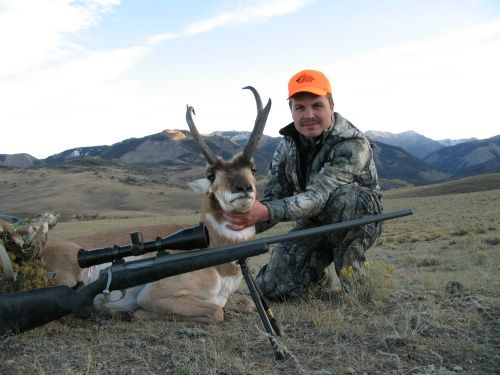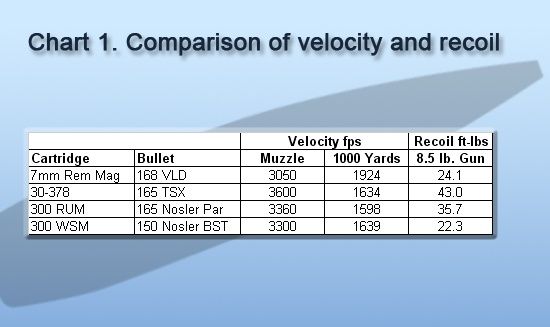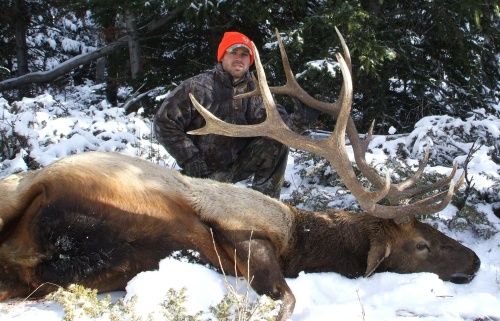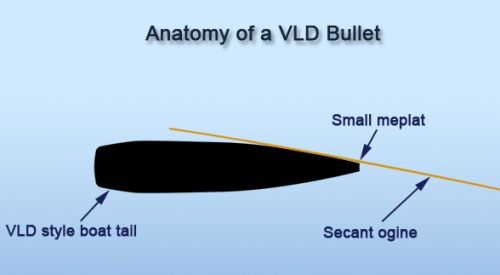
Pronghorn at 625 yards.
You wouldn't be reading this article without the relatively recent development of affordable laser range finders. With the advent of these simple and affordable measuring devices, hunters have been able to increase their effectiveness and ethical shot placement in the field. Once hunters were able to measure an accurate distance to target, they started paying more attention to the external ballistics of their cartridges. Charts and drop tables started showing up on the sides of scopes and rifle stocks, and manufactures started pushing the super magnum cartridges—all in an effort to push the limitations to shooting at distance.
Drop compensating reticles have been around for a while, but without an accurate method for determining distance, they were essentially useless. With a laser range finder, a drop compensating reticle similar to the offerings available in most rife scopes have real merit, but still have limitations for precise compensation for extreme ranges. Under 4-500 yards, hold over reticles are really fast to deploy, but they have limitations. A hunter needs to practice enough to keep track of all the different lines, and a system without wind deflection compensation is not a product an ethical hunter would carry afield. In most cases drop reticles are also built to approximate the trajectory of the majority of rifles with a one size fits most approach—another reason they are only reliable to about 450 yards.
As shooters have evolved and rangefinders improved, more advanced compensation has become mainstream. Dialing an exact adjustment into the elevation turret is the most precise method to compensate for bullet drop at extreme ranges. The traditional method involves referencing a chart calibrated in clicks or MOA for different yardages. For hunting, where shot conditions can change in an instant, a bullet drop compensating turret can be calibrated in yards to match your gun—no more charts! Most scope manufactures are producing or gearing up to produce drop compensators. The trick is to get away from the one size fits all approach and build a custom compensator to precisely match each firearm and bullet's True Ballistic Profile. This is necessary to adjust because of miscalculated B.C.s, errors in chronographs, different firearm reactions, and effects from varied muzzle velocities. Once that process is done, it completely eliminates the guesswork from long range drop compensation—now we need to deal with the wind.
The Gseven rifle scope uses a Ballistic Turret to compensate for drop, and wind holds are accomplised using the G7 reticle. Wind marks are spaced in one MOA increments. Precise wind hold calculations are made automatically with the G7 BR2 ballistic rangefinder. Just dial the compensated ballistic range and hold the wind in the reticle. Its much faster, and more flexible than dialing a separate knob for wind and it eliminates the need to carry a chart or computer in the field. Minute of Angle is pretty handy because we can easily relate a hold value to the reticle (remember one MOA is approximately one inch at 100 yards, four inches at 400 yards, eight inches at 800 yards, etc).
With the new range finders, and precise drop compensating turrets, shooters are capable of precise and ethical shot placement at twice the effective range that conventional equipment was designed for—conventional equipment meaning rifles and ammunition. We'll cover advancements in rifle and barrel technology another time, the topic we are going to discuss in this article is the more important technology advancement of bullet shape an performance.
The first thing we need to define is what makes bullets work. There is no subject with more controversy or misconception in the industry than the perfect bullet design for terminal performance on game. If we mix long range shooting into the question, there are many different claims about the perfect bullet design. We need to sort out the hype, and apply a little science to our bullet selection.
There are basically two parameters that will define how a bullet performs—a bullets shape and its construction. It's generally understood that the shape effects its flight path and velocity, while the construction effects the penetration and expansion. This is true, but the bullets shape also has an effect on the transition from external ballistics to terminal ballistics.
The big picture for terminal ballistics is the bullets impact velocity. Most manufactures have designed and tested their bullets to function for a range of velocities. Generally, we can say 3500 fps at the top end and 2000 fps at the bottom. Really tough bullets may have a range approaching 4000 fps to 2500 fps. The number we are interested in for long range shooting is the lowest velocity at which that bullet will reliably perform on game. By perform I mean penetrate AND expand to make adequate wound cavities and ethical one shot kills. At long range it is easy to get penetration—its the expansion requirement that disqualifies most bullets as contenders.
The reason why is that terminal velocity, and the resulting expansion, is dictated by the bullets initial velocity and its shape. The industry effort revolves around bigger and bigger cases to hold more powder to increase the initial velocity. The 300 RUM with the factory 165 grain bullet starting at 3360 fps has about 1598 fps at 1000 yards. This data was calculated for 5000 feet elevation. With an 8.5 pound gun, the calculated free recoil energy is 36 ft-lbs.
If we use science, instead of a bigger hammer, we can get slightly better down range velocity and energy with 25 percent less recoil! See Chart 1 for a comparison of the velocity, energy and recoil figures. Exploring external ballistics with a simple software program will show the significant effect a bullet's Ballistic Coefficient has on retained velocity downrange. The ballistic coefficient essentially describes the bullets shape and how it is effected by drag.

Chart 1
For North American big game the 7mm diameter bullets have much higher BC's than the 30's or the 338's (for reasonable hunting weight bullets). The cartridge I described earlier launches a 7mm 168 grain VLD at only 3050 fps, and yet it still has more retained velocity at 1000 yards than the 300 RUM with a 165 grain bullet starting at 3360! This kind of velocity can be achieved safely in the 7mm Remington Magnum case with Hodgdon's Retumbo powder—that's right a 7mm Remington Magnum outperforms the 300 Remington Ultra Mag at 1000 yards! The difference is a BC of 0.640 for the 7mm versus 0.410 of the 300. For long range shooting, bullet shape is very important.
The same differences in shape that allow the VLD to outperform the competition for retained velocity, also has an effect on terminal ballistics. Conventional bullets are designed to function at conventional distances—less than 500 yards. In the past, that was all a hunter could ask for, but with cutting edge compensation technology, new designs are necessary. First, conventional bullet shapes do not have high enough BC's for long range performance, unless we drive them with ultra big cartridges. Then the high recoil or muzzle blast is detrimental to accuracy.
Secondly, the current fad of weight retention has almost universally required the addition of some type of expansion initiator. Both an exposed lead tip and a polymer tip initiate the expansion reaction on impact well before any penetration through tissue or bone has occurred. Then, to prevent premature expansion failures, the bullets are designed to be even tougher, and we end up with a bullet that does most of its expansion in the soft tissues and bone before it penetrates to the vitals.

Wyoming elk shot at 1140 yards with the 7mm Rem Mag Gunwerks LR-1000.
With the VLD design, bullet testing and hundreds of field performance evaluations show completely opposite performance. The bullet initially penetrates several inches through bone, muscle, or hide with a delayed expansion reaction that occurs in the vitals—not outside. With the VLD bullet, a shot through the shoulder doesn't create a gaping entry wound with a small wound cavity through the vitals. Instead, you will find a small entry wound with very little soft tissue destruction, excellent penetration through shoulder bones and ribs, and massive wound cavities in the vitals. That is as close to perfect bullet performance as we can expect with today's bullets.
With the VLD design, the balancing act is in controlling the expansion reaction. Several factors contribute to the construction of a bullet that will exhibit consistent penetration and expansion characteristics across a usable velocity spread while retaining the high ballistic coefficient shape necessary for downrange performance. The length of the lead core in the jacket, and the nose crimp and meplat diameter are all variables that contribute to a bullets performance in addition to the jacket material and thickness. The perfect bullet shape and performance is truly a balancing act, and our testing shows that the guys at Berger Bullets have nearly perfected the art. They just need to make more!

The shape of a VLD bullet
One of the questions that we get all the time is about shot placement using VLD bullets. Are we limited in presentation for proper bullet performance? Just evaluate the penetration and expansion characteristics of the VLD shape—initial penetration through several inches of soft tissue and bone, followed by a rapid expansion reaction and large wound cavities. For our North American big game animals, we recommend shot placement slightly more forward and higher than the traditional aim point. With the exceptional penetration characteristics of the VLD, the high-shoulder-shot that is demonstrated on the television show Long Range Pursuit, will stop animals in their tracks, while providing better margins for wind doping. This shot can be made with an animal in any of the quartering to or away positions that are commonly accepted as ethical. Obviously, a rear shot cannot be expected to reach vitals, but will most likely break down the game animal and require a finishing shot. I personally strive for shot placement that will ensure adequate tissue damage for a one-shot kill.
The VLD design is the ultimate for the hunter that has broken through the distance barriers and limitations of traditional equipment. The ability to precisely place your shot at extreme ranges requires a bullet with the proper design for retained velocity and adequate wound channels to ensure ethical performance. The design is so good, and the demand so high, other bullet manufactures will not be far behind in releasing their own VLD hunting bullets. For now, the VLD is the choice for sportsmen wanting to extend their range, without shooting the accuracy robbing, high recoil and muzzle blast of the super magnums.
